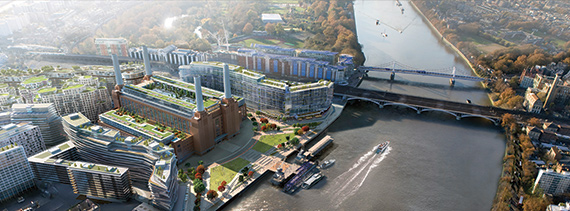Can public realm find the balance between promoting a cultural community and being a development asset? Claire Dutch, planning partner at Hogan Lovells, assesses the issues

Developer attitudes to public realm have changed significantly in recent years. Long gone are the days of equating public realm with rudimentary landscaping in the gaps between the buildings. Public realm is now, more than ever, about creating a sense of place and community.
Sizable areas that are intended to be used, rather than just passed through, are becoming the centrepiece of schemes across London. And creativity plays a huge part. Local authorities can ensure that such spaces do not become sterile testaments to exemplary architecture but instead are actually used for cultural activities.
It is becoming more common for local authorities to require developers to submit a cultural strategy as part of the management plan for such spaces to encourage both informal and formal cultural events. The Battersea Power Station and Nine Elms regeneration in Wandsworth, SW8, which will be designed around a new cultural district including markets, gardens and performance spaces, is a good example.
There are other examples of existing and proposed high-quality multifunctional space in London where the public can relax, play or escape. These include the impressive Granary Square at King’s Cross, N1, with its 1,000 choreographed fountains, and the proposed 2.4-acre raised public park among the rooftops at Bishopsgate Goodsyard, E1.
So why then have commentators criticised the apparent increased “corporatisation” of the public realm?
First, less space is being “adopted” by local authorities. It is not surprising that developers no longer wish to make a swift exit and hand over such land to the local authority as soon as possible. It is crucial to the long-term success of a scheme that such space is maintained to a high specification and used appropriately. As a result, developers often want to retain responsibility in the long term and are, perhaps understandably, reluctant to hand over maintenance liability to cash-strapped local authorities.
Local authorities often accept this. It is not such a bad thing, provided that the developer can convince the local authority that it is committed in the long term and, on occasion, funds are set aside for use in the case of developer default (by way of a bond, a financial deposit in escrow or some other form of guarantee).
Second, a knock-on effect is that less land is being formally “dedicated” to the public. The public do not have a legal right to access such space. The land is accessible with the consent of the developer, which often sets rules regulating entry and behaviour.
This is controversial. London mayor Boris Johnson said in his “London’s Great Outdoors” policy document that the lack of public rights to access can lead to Londoners feeling excluded from parts of their own city.
Recently, there has been disappointment that London’s proposed Garden Bridge is to be effectively a privately managed tourist attraction, rather than a genuinely public thoroughfare.
According to objectors, there is a conflict between the need for a public right to access and the developer’s desire to control the space. Perhaps the issue is more about the inherent unease about the land being under the control of a company that profits from the development, rather than a public body? But the developer wants what the local authority and the public want – a well maintained, safe and pleasant environment that can be enjoyed by all.
Clearly, the extent of the developer’s control needs to be set at the right level. The parameters of what the developer can and cannot do can be set by the local authority in a section 106 agreement. Provided that the developer cannot close the space on a whim or impose overzealous restrictions on activities, is there really a problem? After all, unlike local authorities, developers have the resources to actively manage the space and to react quickly to enforce rules banning antisocial behaviour. In reality, these new spaces will be more accessible than the gated garden squares of west London or London’s royal parks, nearly all of which are highly regulated and closed at night.
With adequate forethought and the right legal commitments, local authorities and developers can work in partnership to create successful and well-used and maintained public realm, creating a scheme where people want to live, work and play.











